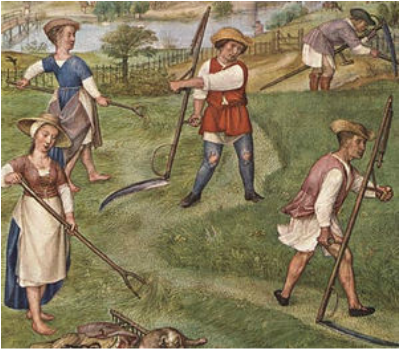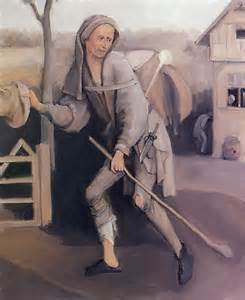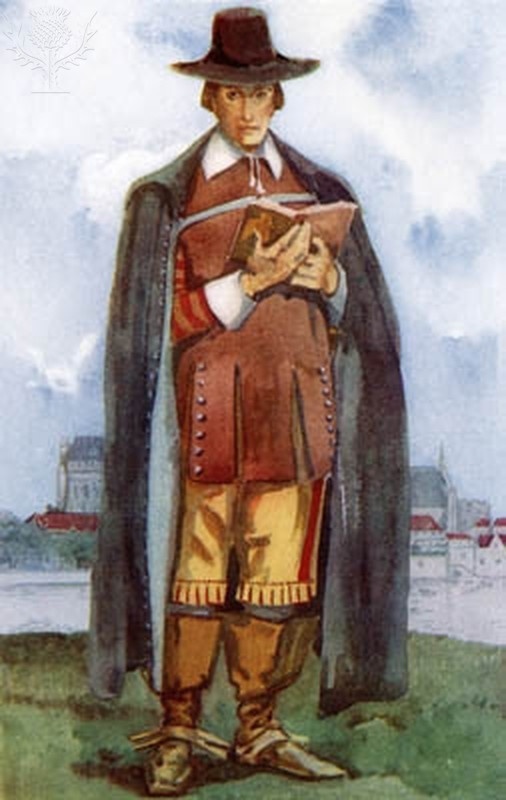|
Ordinary People in
Tudor and Stuart Box Alan Payne October 2015 In Tudor times we begin to get glimpses of ordinary Box residents and their occupations. The information is sketchy and begs lots of questions but it is the first consistent view we have of our predecessors. By the end of the Stuart period we see a much larger village with greater specialisation in employment and a diversification from farming and the wool trade. This is the story of how the changes evolved for ordinary people in Box. |
Social Change
The population of England boomed during the Tudor and Stuart period from 2.4 million in 1520 to 3.3 million in 1570 and 4.5 million by 1600. It was a rate of increase not seen again until the Industrial Revolution and brought enormous social strain. Prices rose steeply after many years of static prices or deflation with average annual inflation of 0.6% in the 1540s; 1% in 1560s and more in the 1570s.
The population of England boomed during the Tudor and Stuart period from 2.4 million in 1520 to 3.3 million in 1570 and 4.5 million by 1600. It was a rate of increase not seen again until the Industrial Revolution and brought enormous social strain. Prices rose steeply after many years of static prices or deflation with average annual inflation of 0.6% in the 1540s; 1% in 1560s and more in the 1570s.
Everyone tried to adjust to the rapidly changing situation. Landlords tried to get out of 90 year leases on fixed rents; yeomen grabbed land field by field; and everywhere there were complaints against the enclosure of common pasture land taken into private ownership to the detriment of ordinary residents.
As always, the losers were the landless whose wages remained static and whose living standards fell perhaps by 40% between 1510 and 1550. Whilst they could survive just in good years they failed in old age or when there were too many children.
As always, the losers were the landless whose wages remained static and whose living standards fell perhaps by 40% between 1510 and 1550. Whilst they could survive just in good years they failed in old age or when there were too many children.
|
Bad harvests, such as 1520s, 1550s and 1570s, hit these people hard. In the 1590s there were four years in a row and death from starvation became a real issue. To survive, cottagers were obliged to glean fields for grains of corn after a harvest.
Vagrancy became an increasing problem with beggars, thieves and vagabonds roaming the countryside looking for opportunities. Some attempt was made to remedy matters. The vagrant poor could be sent to new colonies in Virginia. A group of commonwealth men (protestant clergy) preached against covetousness and in favour of the impotent poor (the sick and the elderly). And the fear of a Catholic reaction was always present. Right: Tudor pauper (courtesy http://cookit.e2bn.org/historycookbook/32-337-Life-in-tudors.html) |
Tudor People
Some of the earliest information is in 1539 when there is documentary evidence of Henry VIII's Muster Rolls (militia lists of those able to serve in an army should England be invaded).[1] It records 42 male inhabitants in the Tything of Box (portion of the Chippenham area) aged 16 to 60 able to fight: 17 archers and 25 Byllmen (men with billhook weapons). The archers may have had weapons but many of the billmen probably had only agricultural implements. They were all probably working in agriculture. The area was not expecting military action having ready only 2 horses and 3 harnesses: The whole Tything hath in a redynes ij (two) horses, and iij (three) harnes, with other small wepyns.
The Fines (Fees) payable on inheriting land in Tudor times show references to Box during the reign of Henry VIII.[2] Sometimes they give lots of information, such as in 1537 when Richard and William Preedy inherited one mill and lands in Boxe through William's wife Elizabeth, daughter and heir of John George. Other references recall names that become commonplace in the village including in 1539 when John Butler and William & Ellen Danyells acquired half a messuage (house) and lands in Ridelawe near the parish of Box on payment of 40 marks (£26.13s.4d).
Aspiring Tudor People in Box
The Tudor need for money gives us many more details of the wealthier residents.[3] In 1545 the list comprised many names we recognise in other articles: Anne Bonham, (widow), Nycolas Nowell, John Nowell, John West, Lewes Melly (vicar), William Nowell, William Bisson, Henry Coggeswell.
By 1576, the needs of Elizabethan government required much more money and the list of ratepayers grew considerably to include: Anthony Longe (gent), Myechell Nowell, Richard Brode, John Chertenam, Anthonne Groome, George Mouce, Thomas Balden, Philippe Bolwell, Edward Butler, Robert Boynes, William Flower, Thomas Sympson (the elder), John Cone, William Pynchen, Robert Symons, William Beezie, John Weste, Richard Boster, John Tayler and John Curtes.
The main advocates of change locally were the upwardly mobile: yeomen and husbandmen farmers, workers in the clothing industry, artisans and respectable quarry workers. They were able to exploit unstable economic, religious and political circumstances and in so doing they established a role for themselves in respectable Box society. These people were sober, religious folk who worked hard and advanced themselves by responding quickly to market changes, producing goods for sale at market, rather than for personal consumption.[4] They valued their status as men of credit and reputation and they invested in the area acquiring properties in the hamlets to pass on to their children.
In social matters these advocates of change challenged the old established order based on deference to the squire, the parson and the collective decisions of the manorial court. The manorial court at Nettleton in 1615 reflected the concerns of old order: keeping hedges in good repair; not allowing animals to stray; not butchering pigs on the street.[5] As the new order progressed, such matters became the personal responsibility of any godly (self-respecting) person: all the manorial court did was to reduce personal ambition to the lowest common denominator. The aspiring people concentrated on market needs and wanted to graze their own animals when it suited them; not dictated by custom, precedent and the wisdom of the elders.
Some of the earliest information is in 1539 when there is documentary evidence of Henry VIII's Muster Rolls (militia lists of those able to serve in an army should England be invaded).[1] It records 42 male inhabitants in the Tything of Box (portion of the Chippenham area) aged 16 to 60 able to fight: 17 archers and 25 Byllmen (men with billhook weapons). The archers may have had weapons but many of the billmen probably had only agricultural implements. They were all probably working in agriculture. The area was not expecting military action having ready only 2 horses and 3 harnesses: The whole Tything hath in a redynes ij (two) horses, and iij (three) harnes, with other small wepyns.
The Fines (Fees) payable on inheriting land in Tudor times show references to Box during the reign of Henry VIII.[2] Sometimes they give lots of information, such as in 1537 when Richard and William Preedy inherited one mill and lands in Boxe through William's wife Elizabeth, daughter and heir of John George. Other references recall names that become commonplace in the village including in 1539 when John Butler and William & Ellen Danyells acquired half a messuage (house) and lands in Ridelawe near the parish of Box on payment of 40 marks (£26.13s.4d).
Aspiring Tudor People in Box
The Tudor need for money gives us many more details of the wealthier residents.[3] In 1545 the list comprised many names we recognise in other articles: Anne Bonham, (widow), Nycolas Nowell, John Nowell, John West, Lewes Melly (vicar), William Nowell, William Bisson, Henry Coggeswell.
By 1576, the needs of Elizabethan government required much more money and the list of ratepayers grew considerably to include: Anthony Longe (gent), Myechell Nowell, Richard Brode, John Chertenam, Anthonne Groome, George Mouce, Thomas Balden, Philippe Bolwell, Edward Butler, Robert Boynes, William Flower, Thomas Sympson (the elder), John Cone, William Pynchen, Robert Symons, William Beezie, John Weste, Richard Boster, John Tayler and John Curtes.
The main advocates of change locally were the upwardly mobile: yeomen and husbandmen farmers, workers in the clothing industry, artisans and respectable quarry workers. They were able to exploit unstable economic, religious and political circumstances and in so doing they established a role for themselves in respectable Box society. These people were sober, religious folk who worked hard and advanced themselves by responding quickly to market changes, producing goods for sale at market, rather than for personal consumption.[4] They valued their status as men of credit and reputation and they invested in the area acquiring properties in the hamlets to pass on to their children.
In social matters these advocates of change challenged the old established order based on deference to the squire, the parson and the collective decisions of the manorial court. The manorial court at Nettleton in 1615 reflected the concerns of old order: keeping hedges in good repair; not allowing animals to stray; not butchering pigs on the street.[5] As the new order progressed, such matters became the personal responsibility of any godly (self-respecting) person: all the manorial court did was to reduce personal ambition to the lowest common denominator. The aspiring people concentrated on market needs and wanted to graze their own animals when it suited them; not dictated by custom, precedent and the wisdom of the elders.
The Market Place had probably become an area for craftwork and the manufacturing of goods, where men proclaimed their trade by fixing tools above their house door.[9] They were not specifically retail shops as we know them today (such as butchers, grocers or bakers) because these tasks were usually undertaken domestically and by travelling tradesmen.[10] Rather there were artisan's workshops and yards for trades such as cobblers (shoe-maker and -repairer), wheelwrights (who repaired most vehicles from dung carts to milk floats) and basket-makers (using willow withies to make beehives, egg baskets and coal scuttles).[11]
Regulating these merchants to sell at approved prices caused much concern to the Stuart government.[12] Numerous Box traders were reported to the Court of Exchequer in 1611-15: Richard Felkes and William Butcher at Rudlow, George Mison at Wadswick and George Nuzen of Henley, all of whom dealt in wheat, arable and legumes; Cornelius Marshe and William Rynell of Box who bought and sold cattle; and Richard Butler of Box for buying woollen yarn for resale rather than cloth-making.[13]
Glovers Lane in Box probably dates from this time. In 1646 in the will of John Bayley, alias Clerk (possibly illegitimate whose father was Mr Clerk), John was described as a tanner and this was probably a family business because in 1704 Thomas Baily called himself a glover.[14] We shouldn't assume that the lane was an industrial area. The pedestrian access from Townsend to the Market Place is too narrow for carts or farm animals and the lane was a street of houses that specialised in making highly fashionable gloves out of sheep hides, a sub-division of the local sheep industry.
The making of gloves could be highly profitable. Ralph Robinson of Box is specifically mentioned as a tailor (possibly meaning glover rather than a broadcloth weaver) as early as 1577.[15] The stonewalls of properties adjacent to Glovers Lane date from the 1600s, two metres high, which indicate local affluence to allow expensive building material to be used for domestic garden walls.
Regulating these merchants to sell at approved prices caused much concern to the Stuart government.[12] Numerous Box traders were reported to the Court of Exchequer in 1611-15: Richard Felkes and William Butcher at Rudlow, George Mison at Wadswick and George Nuzen of Henley, all of whom dealt in wheat, arable and legumes; Cornelius Marshe and William Rynell of Box who bought and sold cattle; and Richard Butler of Box for buying woollen yarn for resale rather than cloth-making.[13]
Glovers Lane in Box probably dates from this time. In 1646 in the will of John Bayley, alias Clerk (possibly illegitimate whose father was Mr Clerk), John was described as a tanner and this was probably a family business because in 1704 Thomas Baily called himself a glover.[14] We shouldn't assume that the lane was an industrial area. The pedestrian access from Townsend to the Market Place is too narrow for carts or farm animals and the lane was a street of houses that specialised in making highly fashionable gloves out of sheep hides, a sub-division of the local sheep industry.
The making of gloves could be highly profitable. Ralph Robinson of Box is specifically mentioned as a tailor (possibly meaning glover rather than a broadcloth weaver) as early as 1577.[15] The stonewalls of properties adjacent to Glovers Lane date from the 1600s, two metres high, which indicate local affluence to allow expensive building material to be used for domestic garden walls.
Wealthy Stuart Residents, 1628
The rateable valuation of Box and Ditteridge gives us a view of the landed class in Box, about who and how much each of the propertied residents should contribute to the parish rates in 1628.[16]
The rateable valuation of Box and Ditteridge gives us a view of the landed class in Box, about who and how much each of the propertied residents should contribute to the parish rates in 1628.[16]
| 1628_rates_2015-07-01.doc | |
| File Size: | 84 kb |
| File Type: | doc |
|
There are fifty-six residents listed for the parish of Box, one at Hazelbury and seven for Ditteridge. The list does not include the sub-tenants (although many would have had costs passed on to them as in the case of Lady Cornwallis referred to in the listing) and it excludes those in commerce or other businesses.
Although the burden of taxation was scaled, we should beware of calling it progressive. George Speke was valued at £330 (21% of the total), Henry Long £140 (9%) and Peter Webb £72 (5%) but in 29 cases listed the owners are just holders of a tenement (house with large garden but not as big as a smallholding farm) who were valued at £357 (23% of the total). Many of the other residents were agricultural labourers, casual workers and women, none of whom generated much in the way of reserve funds. Property Winners and Losers We see a huge volume of property transaction in the early 1600s.[17] Sometimes the arrangements were mutually agreeable, sorting out old strips of land in the common fields which were of limited value because of their size; sometimes they reflected the impoverishment and bankruptcy of the previous owner. Right: Depiction of Protestant land owner (courtesy Wikimedia Common) |
John Moxsam held three separate parts (strips) of land in the common fields of Box which he sold to Hugh Speke in 1610 whilst still retaining land worth £11 at Wadswick in 1628. Similarly, Anthony Baldwin was seised of 2 several tenements in Box (Fields) as well as one other tenement, with a curtilage (house plot), orchard and garden and 3 acres of arable land pertaining, which he sold freehold to Hugh and George Speke in 1613. He retained other, more valuable land, including a tenement worth £18 in 1628.
We can see some of the people who profited. William Butcher at Rudloe was a corn merchant in 1612 who invested profits in land and held a tenement worth £15 in 1628.[18] Michael Bolwell and Richard Chapman held valuable farms at Ditteridge, and were probably related to the miller John Bolwell. The developing yeomen usually emerged from the ranks of the customary tenants who had considerable local knowledge, having been involved in the financial and administrative affairs of the manorial court and the demesne lord's officials.
Aspiring husbandmen farmers (often peasants) rented a virgate (about 25 acres) and combined mixed farming, dairying or beef breeding with domestic spinning or weaving. These people were deeply concerned about civil disorder and used courtesy titles of master and mistress rather than reminders of their medieval, unfree status goodman and neighbour.[19]
Literacy and a rapidly altering society, were driving fundamental changes in Box but we shouldn' think that many people were educated. Four local notables affirmed the 1628 Rateable Valuation as well as the lord of the manor, George Speke. They were the most responsible residents of the parish who agreed the valuation and collected the parish rates due but Anthony Balden and William Clement were illiterate and signed with their mark.
It all came at a cost. Against the background of so much change in religion and society came a national conflict for power between the King and Parliament; so much social change was the spark that ignited a bloody civil war in England.
We can see some of the people who profited. William Butcher at Rudloe was a corn merchant in 1612 who invested profits in land and held a tenement worth £15 in 1628.[18] Michael Bolwell and Richard Chapman held valuable farms at Ditteridge, and were probably related to the miller John Bolwell. The developing yeomen usually emerged from the ranks of the customary tenants who had considerable local knowledge, having been involved in the financial and administrative affairs of the manorial court and the demesne lord's officials.
Aspiring husbandmen farmers (often peasants) rented a virgate (about 25 acres) and combined mixed farming, dairying or beef breeding with domestic spinning or weaving. These people were deeply concerned about civil disorder and used courtesy titles of master and mistress rather than reminders of their medieval, unfree status goodman and neighbour.[19]
Literacy and a rapidly altering society, were driving fundamental changes in Box but we shouldn' think that many people were educated. Four local notables affirmed the 1628 Rateable Valuation as well as the lord of the manor, George Speke. They were the most responsible residents of the parish who agreed the valuation and collected the parish rates due but Anthony Balden and William Clement were illiterate and signed with their mark.
It all came at a cost. Against the background of so much change in religion and society came a national conflict for power between the King and Parliament; so much social change was the spark that ignited a bloody civil war in England.
References
[1] North Wiltshire Musters, 1539, Chippenham Hundred, Ancestry.com
[2] A Calendar of Feet of Fines for Wiltshire, Wiltshire Notes & Queries, Vol 2, 1896 -98, p.424-5
[3] Wiltshire Archaeological and Natural History Society, Records Branch, Vol X, 1954
[4] David Underdown, Revel, Riot and Rebellion, 1987, Oxford University Press, p.4
[5] David Underdown, Revel, Riot and Rebellion, p.13
[6] Wiltshire Record Society, Vol 15, p.4
[7] Wiltshire Record Society, Vol XV, Early Stuart Tradesmen
[8] Wiltshire Record Society, Vol 15, p.90
[9] Christopher Hibbert, The English: A Social History 1066-1945, 1987, Harper Collins, p.307
[10] WE Tate, The English Parish Community, 1967, The Camelot Press, p.28
[11] Heather & Robin Tanner, Wiltshire Village, 1939, Collins, p.72, 79
[12] John Hare, A Prospering Society, 2011, University of Hertfordshire, p.90
[13] Wiltshire Record Society, Vol 15, p.62-90
[14] http://history.wiltshire.gov.uk/heritage/wills, WRO
[15] Wiltshire Record Society, Vol 4, p.26
[16] Wiltshire Archaeological and Natural History Society, Vol XLIII
[17] For details see from Wiltshire Archaeological and Natural History Society, Vol XLIII, p.339-340; Allen's 1630 map; and Inquisitiones Post Mortem, Hugh Speke, Esquire, p.5-12
[18] Wiltshire Record Society, Vol 15, p.65 and Wiltshire Archaeological and Natural History Society, Vol XLIII, p.340
[19] Martin Ingram, Church Courts, Sex and Marriage in England 1570-1640, 1987, Cambridge University Press, p.71
[1] North Wiltshire Musters, 1539, Chippenham Hundred, Ancestry.com
[2] A Calendar of Feet of Fines for Wiltshire, Wiltshire Notes & Queries, Vol 2, 1896 -98, p.424-5
[3] Wiltshire Archaeological and Natural History Society, Records Branch, Vol X, 1954
[4] David Underdown, Revel, Riot and Rebellion, 1987, Oxford University Press, p.4
[5] David Underdown, Revel, Riot and Rebellion, p.13
[6] Wiltshire Record Society, Vol 15, p.4
[7] Wiltshire Record Society, Vol XV, Early Stuart Tradesmen
[8] Wiltshire Record Society, Vol 15, p.90
[9] Christopher Hibbert, The English: A Social History 1066-1945, 1987, Harper Collins, p.307
[10] WE Tate, The English Parish Community, 1967, The Camelot Press, p.28
[11] Heather & Robin Tanner, Wiltshire Village, 1939, Collins, p.72, 79
[12] John Hare, A Prospering Society, 2011, University of Hertfordshire, p.90
[13] Wiltshire Record Society, Vol 15, p.62-90
[14] http://history.wiltshire.gov.uk/heritage/wills, WRO
[15] Wiltshire Record Society, Vol 4, p.26
[16] Wiltshire Archaeological and Natural History Society, Vol XLIII
[17] For details see from Wiltshire Archaeological and Natural History Society, Vol XLIII, p.339-340; Allen's 1630 map; and Inquisitiones Post Mortem, Hugh Speke, Esquire, p.5-12
[18] Wiltshire Record Society, Vol 15, p.65 and Wiltshire Archaeological and Natural History Society, Vol XLIII, p.340
[19] Martin Ingram, Church Courts, Sex and Marriage in England 1570-1640, 1987, Cambridge University Press, p.71



